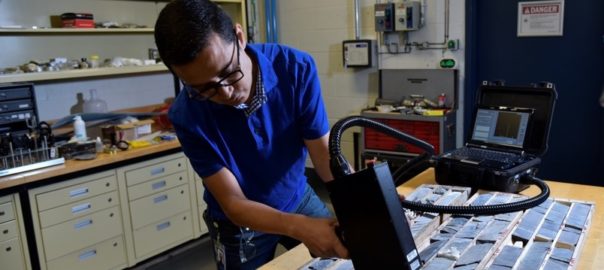The Cooperative Research Centre for Optimising Resource Extraction (CRC ORE) and the National Research Council of Canada (NRC) have partnered on a project to bring the benefits of laser-induced breakdown spectroscopy (LIBS) chemical element analysis to the mine site.
LIBS, a rapid chemical element analysis technique, is used in a variety of applications including analysis of soil, effluents, scrap metal, alloy and molten metals. It works through a focused laser pulse striking the sample surface and removing an amount of material to generate a high-temperature plasma plume. Atoms and ions are excited to higher energy levels and, while returning into their ground state, emit characteristic energy signatures for each element.
The robustness of LIBS is well suited for real-time minerology analysis and at all stages of the mining production cycle, according to CRC ORE, with commercially available laboratory-based quantitative mineral analysers (QMA) – such as QEMSCAN and MLA – historically used in mining.
“However, these technologies are not suited for in-stream or on-belt applications due to their meticulous sample preparation and measurement protocols,” the centre said. The analysis is limited to costly lab-based sampling, which requires the extraction of extensive samples and the transport of these to lab facilities, sometimes many hundreds of kilometres away from the mine site, according to CRC ORE.
To provide a timelier solution to the mining industry, the CRC is working with the NRC to explore the use of LIBS sensor technology for applications such as mineral characterisation across a conveyor belt. Additionally, the use of LIBS is being examined as an industrialised elemental and mineralogical analyser for scanning coarse rock streams.
CRC ORE Program Coordinator, Dr Greg Wilkie, said the two organisations are taking LIBS use in the mining industry to the next level by putting the technique to use in operating mine sites.
“By applying LIBS in a real-time application, such as across an operating conveyor belt, operators are empowered with high volumes of rapid analysis provided in real time,” Dr Wilkie said. “Analysis in real time speeds up the mineralogy process, providing operators with detail they may have previously had to wait days or weeks to obtain.”
He added: “We are proudly putting the minerology back into process minerology.”
The NRC’s Senior Research Officer, Dr Alain Blouin, said the NRC and CRC ORE are working on a long-term LIBS project, which is nearing the end of an intensive two-year study.
“We are developing a novel application of a LIBS rapid on-line mineralogical characterisation instrument suitable for deployment on mine sites,” Dr Blouin said. “LIBS can measure a large number of elements simultaneously with the ability to detect light elements beyond the capability of many other techniques.”
Dr Wilkie said since LIBS can perform analysis several metres away from what it is measuring and still detect extremely low concentrations it is well suited technology for the mining industry.
“Beyond cross-belt scanning, LIBS can work in a variety of settings from in-pit muckpiles, underground draw points and on-line slurries,” Dr Wilkie said.
It is anticipated that the real-time LIBS solution be used in conjunction with CRC ORE’s Grade Engineering® – an approach to the early separation of ore from waste material. Grade Engineering is minimising the impact of declining grades and productivity in the Australian and global minerals sector, according to CRC ORE.






